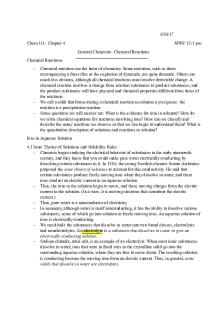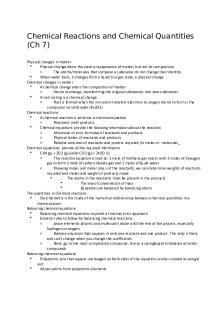CHEM 1211K - Observing Chemical Reactions Report Sheet PDF

| Title | CHEM 1211K - Observing Chemical Reactions Report Sheet |
|---|---|
| Author | Brad Herrick |
| Course | Basics Of Chemistry |
| Institution | University of Georgia |
| Pages | 4 |
| File Size | 134.1 KB |
| File Type | |
| Total Downloads | 69 |
| Total Views | 142 |
Summary
lab 01...
Description
Lab 1 Report Sheet Title:
Date:
Name:
Lab Partner(s):
Purpose: Prepare for the lab by answering the following questions. Use complete sentences, avoiding the use of “I” or “we”. Check with your instructor to see whether you should just respond to the questions or if you should place your responses in a single paragraph. 1. What is the main topic/concept being investigated today? 2. How will you investigate this topic/concept? 3. Write the main definitions and equations needed for today’s experiment.
Reaction Set #1 Table 1: Observations for Reaction (1a) Reagent Initial Observations During Reaction
After Reaction
Reaction type?
Pb(NO3)2
K2CrO4
1
Table 2: Observations for Reaction (1b) Reagent Initial Observations During Reaction
After Reaction
Reaction type?
After Reaction
Gas identity?
Pb(NO3)2
Na2SO4
Reaction Set #2 Table 3: Observations for Reaction (2a) Reagent Initial Observations During Reaction HCl Reaction type? Mg
Table 4: Observations for Reaction (2b) Reagent Initial Observations During Reaction
After Reaction
Gas identity?
H 2O 2 Reaction type? KMnO4
Table 5: Observations for Reaction (2c) Reagent Initial Observations During Reaction
After Reaction
Gas identity?
HC2H3O2 Reaction type? NaHCO3
2
Reaction Set #3 Table 6: Observations for Reaction (3a) Reagent Initial Observations During Reaction
After Reaction
Reaction type?
After Reaction
Reaction type?
NaOH
HCl
Table 7: Observations for Reaction (3b) Reagent Initial Observations During Reaction Water
NH4Cl
Calculations: 1. Provide balanced chemical equations for each of the chemical reactions that you performed. [Reaction (2b) is omitted here.] (1a) _______ Pb(NO3)2 (aq) + ________ K2CrO4 (aq) → ________ KNO3 (aq) + ________ PbCrO4 (s) (1b) _______ Pb(NO3)2 (aq) + ________ Na2SO4 (aq) → ________ NaNO3 (aq) + ________ PbSO4 (s) (2a) _______ HCl (aq) + ________ Mg (s) → ________ MgCl2 (aq) + ________ H2 (g) (2c) _____ HC2H3O2 (aq) + ______ NaHCO3 (s) → ______ NaC2H3O2 (aq) + _____ H2O (l) + _____ CO2 (g) (3a) _______ NaOH (aq) + ________ HCl (aq) → ________ NaCl (aq) + ________ H2O (l) (3b) _______ NH4Cl (aq) → ________ NH4+ (aq) + ________ Cl– (aq)
Analysis & Discussion: 1. Which of the above reactions can be classified as precipitation reactions? [You can list by reaction number.]
2. Which of the above reactions can be classified as gas evolution reactions? 3
3. Which of the above reactions had non-visual clues that a reaction had taken place? In this case, what indicated that a chemical reaction had occurred?
Conclusion Summarize the lab by answering the following questions in your lab notebook. Check with your instructor to see whether you should just respond to the questions or if you should place your responses in a single paragraph. 1. What was the main topic/concept investigated in the lab? 2. How was this concept investigated? 3. What were the main results found in this experiment?
4...
Similar Free PDFs

Chem 111 Ch 4 Chemical Reactions
- 17 Pages

Bill Nye Chemical Reactions
- 2 Pages

Rates of Chemical Reactions
- 9 Pages

Types of chemical reactions
- 4 Pages

Chapter 15 Chemical Reactions
- 21 Pages

Chemical reactions equations
- 6 Pages

Balancing Chemical Reactions
- 4 Pages

Lecture 8: chem reactions
- 15 Pages
Popular Institutions
- Tinajero National High School - Annex
- Politeknik Caltex Riau
- Yokohama City University
- SGT University
- University of Al-Qadisiyah
- Divine Word College of Vigan
- Techniek College Rotterdam
- Universidade de Santiago
- Universiti Teknologi MARA Cawangan Johor Kampus Pasir Gudang
- Poltekkes Kemenkes Yogyakarta
- Baguio City National High School
- Colegio san marcos
- preparatoria uno
- Centro de Bachillerato Tecnológico Industrial y de Servicios No. 107
- Dalian Maritime University
- Quang Trung Secondary School
- Colegio Tecnológico en Informática
- Corporación Regional de Educación Superior
- Grupo CEDVA
- Dar Al Uloom University
- Centro de Estudios Preuniversitarios de la Universidad Nacional de Ingeniería
- 上智大学
- Aakash International School, Nuna Majara
- San Felipe Neri Catholic School
- Kang Chiao International School - New Taipei City
- Misamis Occidental National High School
- Institución Educativa Escuela Normal Juan Ladrilleros
- Kolehiyo ng Pantukan
- Batanes State College
- Instituto Continental
- Sekolah Menengah Kejuruan Kesehatan Kaltara (Tarakan)
- Colegio de La Inmaculada Concepcion - Cebu







